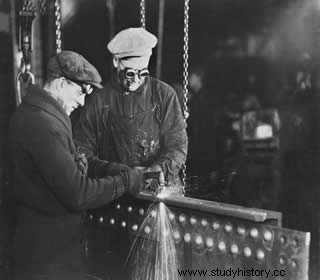
By Tales Pinto
The Industrial Revolution had as one of its consequences the profound transformation in the form of economic and social organization in the places where it took place, and, in the 20th century, this transformation reached almost the entire planet. The change in working methods was at the origin of the Industrial Revolution, moving from an organization of the artisanal production process, characteristic of craft corporations, to manufacturing, at the beginning of the revolution.
However, the social struggles that took place between the so-called first and second Industrial Revolutions, as well as the technological innovations in the production process resulting from this struggle, led to the expansion of companies and a concentration greater number of workers in the workplace, marking the beginning of large-scale industry, from the mid-19th century onwards.
It was in this context that taylorism as a way of organizing workers in the production process, adopting work methods considered scientific and more efficient.
The term Taylorism derives from the name of the American engineer Frederick Winslow Taylor , who worked as a laborer and engineer in industrial companies in the USA. Taylor carefully observed the workers and noticed that there was a control of the rhythms in the work processes by the most experienced workers. They were still the ones who taught the novice workers the work to be carried out in the factories. This situation concentrated the knowledge necessary for the manufacture of goods in the most experienced workers, who, in order to reduce the profits of the bosses, maintained a slow rhythm of production, in addition to giving them an authority within the companies.
To break with this situation, Taylor sought throughout his life to remove this knowledge – and authority – about the workers' production process. The path found was to observe the gestures made by workers in the process of producing goods, to isolate them and teach them to the workers. In this way, he avoided that production vices and the reduction of the work rhythm were taught from one worker to another. By isolating the gestures, Taylor was able to make them more efficient, eliminating unnecessary movements.
Equipped with stopwatches, Taylor and his assistants also stipulated a minimum time to perform the gestures and, in this way, produce as quickly as possible the parts of the goods they were responsible for manufacturing. . Faced with workers' resistance to following these guidelines, Taylor sought to encourage workers to pay wages according to the quantity of parts produced, intensifying the increase in workers' productivity.
Taylor's result was surprising, as he managed to significantly increase productivity, intensifying the division of labor, in addition to reducing the power of workers within companies. His experiences were recorded in some works, among which the book Principles stands out. Scientific Management . The book became a reference for the processes of rationalization of work in various economic sectors, since its method could be applied in any sector, from civil construction to office work.
